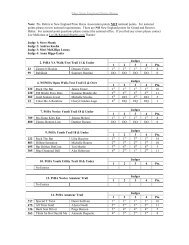2011 Official Rule Book - New England Pinto Horse Association
2011 Official Rule Book - New England Pinto Horse Association
2011 Official Rule Book - New England Pinto Horse Association
You also want an ePaper? Increase the reach of your titles
YUMPU automatically turns print PDFs into web optimized ePapers that Google loves.
B. This fee must be forwarded to the PtHA business office with<br />
the show results.<br />
C. No show results will be tabulated until this fee is paid in full.<br />
G5. General and Exhibitor Conduct<br />
A. Any person acting, inciting or permitting others to act in<br />
a manner contrary to the rules of the <strong>Association</strong>, or in a<br />
manner deemed unsportsmanlike, improper, unethical,<br />
dishonest, intemperate, or prejudicial to the best interests of the<br />
<strong>Association</strong>, shall be reported to the <strong>Association</strong> and subject to<br />
disciplinary procedures.<br />
B. An exhibitor may make a request through the ringmaster or<br />
other show official to speak with a judge concerning his/her<br />
opinion or decision. Such discussion should take place in the<br />
presence of the ringmaster or other show official; however,<br />
there shall be no fraternization between an exhibitor and<br />
a judge during the show, either in the show pen or in any<br />
common area at the show facility.<br />
G6. stallions<br />
A. Persons eighteen (18) years of age and under are prohibited<br />
from showing colts or stallion horse, pony or miniature in any<br />
class.<br />
B. For showing purposes the <strong>Association</strong> considers a colt an<br />
unaltered male under the age of four (4) years. An altered<br />
male is a gelding, regardless of age.<br />
G7. Combination of Types and seats<br />
A. All classes are open to all types of <strong>Pinto</strong>s, with restrictions only<br />
to the type of equipment being used in a given class, per class<br />
specifications.<br />
B. “Type” refers to the conformation type of the <strong>Pinto</strong>, and “seat”<br />
refers to the equipment used on the <strong>Pinto</strong>. To help alleviate<br />
confusion for both show management and exhibitors regarding<br />
the differences between type and seat in the classes, the<br />
following examples are given for reference regarding type of<br />
equipment required for specified “seat:”<br />
Class Name Equipment Type<br />
Park <strong>Horse</strong> Saddle Seat<br />
3-Gaited or 5-Gaited Saddle Seat<br />
3-Gaited/Park <strong>Horse</strong> Saddle Seat<br />
Hunter Under Saddle Hunter Seat<br />
English Pleasure Hunter/Saddle Seat<br />
English Pleasure, Hunter Seat Hunter Seat<br />
English Pleasure, Saddle Seat Saddle Seat<br />
Western Pleasure Stock Seat<br />
C. There shall be no discrimination regarding style of riding of any<br />
type of horse or pony exhibited in any combined class.<br />
G8. Exhibitor, Groom, attendant, Header, Tailer<br />
appearance<br />
A. Attire<br />
1. It is the tradition of the show ring that riders, drivers, and<br />
handlers be correctly attired for the class in question, that<br />
attendants/grooms/headers etc. be neatly dressed, and<br />
<strong>Horse</strong>s, Ponies or Miniatures be properly presented.<br />
a. Exhibitors in all classes where jumping is required<br />
must wear protective headgear, except in Trail classes.<br />
b. Protective headgear is recommended in all classes<br />
where possible.<br />
c. All classes, including halter, shall require the exhibitor<br />
to be properly attired for the type of style of <strong>Pinto</strong><br />
presented (i.e. no western apparel of any kind shall be<br />
allowed in English classes.)<br />
<strong>2011</strong> PtHA <strong>Rule</strong> <strong>Book</strong> 65<br />
sHows



